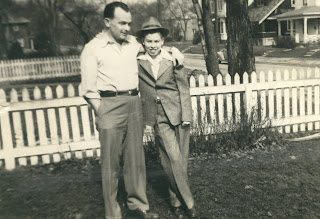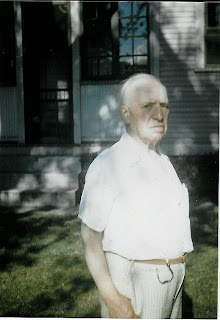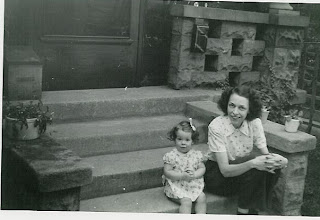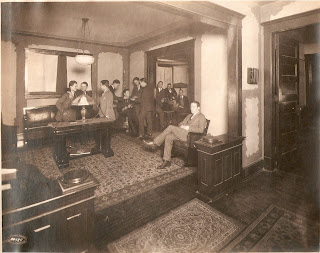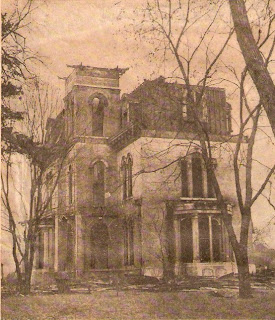



Orion Avenue is a quiet street located south of the Baltimore and Ohio Railroad, west of Emerson Avenue, and north of Brookville Road. It is a short street that most Irvingtonians have not likely driven down. While most of the housing stock along the avenue dates from the 1920s and later, there is at least one very old cottage located at 5014.
The 1889 map of Irvington shows a structure on the site. Orion used to be called Nora and South Bancroft was formerly known as Parker. Irvington founder, Levi Ritter owned the acreage around the home, but he lived in a grand place at the southeast corner of East Washington Street and Ritter Avenue.
The earliest known family to call 5014 home were the Coffins. George W. and Louisa Fulwider Coffin planned to spend their retirement years in the home and they moved into the house in 1908. The large lot was perfect for Mr. Coffin because he loved to garden and he sold his vegetables and flowers at the Indianapolis City Market. The house used to have the address of 4876 Orion, but it was changed in 1917 to 5014. The Coffins, both in their sixties, usually kept boarders. In 1910, two ministers named Summer Robinson, 21, and Frederick Jacobs, 27, lived in the home. By 1915, Mrs. Coffin's health appeared to be failing and the couple left to stay with children. Eventually, she passed away in Oak Park, Illinois on October 17, 1915. Mr. Coffin would live until 1926. Both were buried in their native Montgomery County, Indiana.
The Rubush family moved into house in 1915 and remained until the 1930s. William Rubush was a brick mason and contractor and worked on many landmarks and memorials around the city of Indianapolis. His wife, Clara Jenne Rubush, ran the household. Both of the Rubush's were members of the Universalist Church in Oaklandon in northeastern Marion County. They raised five children in the house. Their daughters Zerelda and Ada attended the Hibben Dance School in Irvington in 1921 and Zerelda later sang in the opera The Pirates of Penzance at Butler University on January 11, 1923. Both daughters would become teachers with Zerelda moving to Paris, France. One son, Jack Rubush, became a sheriff in Hancock County, Indiana, while another son, Richard Rubush, worked in a variety of jobs.
Tragedy awashed the Rubush family on May 28, 1923, when their twenty-two-year-old son, Theodore was struck by a train and killed. Theodore had just married Dorothy King and was living at 4001 East Washington Street. He was on his first day of a job delivering the Indianapolis Sunday Star near Julietta, Indiana in eastern Marion County. He had recruited his fifteen-year-old brother-in-law, David King, to drive his auto while he passed out newspapers. As young David was driving the car, it stalled on the Baltimore and Ohio tracks. A new driver, he threw the car into reverse and the auto stalled once again. Theodore was killed instantly while David survived with some terrible injuries. The Rubush's held the funeral in their home at 5014 Orion Avenue. Sadly for the Rubush family, the property abuts the Baltimore and Ohio Railroad so they likely thought of their son daily as the train conductors blew their whistles to announce the train's arrival to Irvington at Emerson Avenue.
The Swain family lived in the home in the early 1940s and then the Thompsons moved into 5014 in 1944. They would remain for several decades. Rodney Thompson worked for Irvington Ice and Coal on South Ritter and eventually worked his way up to managing the facility. The Thompsons raised their children in the cottage on the large lot. More information will be forthcoming on this interesting family.
Each house has its own story to tell. What other tales remain from this one small home on this quiet street? More research is needed not only on this house, but on many others along Orion Avenue.
In the top photo, courtesy of Kathleen Lynch, you can see Louisa Fulwider Coffin, as a passenger in her brother's car. The three women in the backseat of the car, are Louisa's sisters. She was visiting the family in Montgomery County, Indiana near New Richmond when this photo was taken around 1910.
In the second photo, you can see two views of 5014 Orion Avenue. The bottom part of the photo shows the home in 1944 just after the Thompsons planted some evergreen trees. In the top part of the photo, you can see the house in 1950. The trees had started to grow. These photos are courtesy of Sue Thompson.
It is nearly impossible to get a contemporary view of the house in 2012 because the Thompson trees now tower over the home nearly seventy years after these photos were taken, however, you will note that the dwelling has been enlarged.

